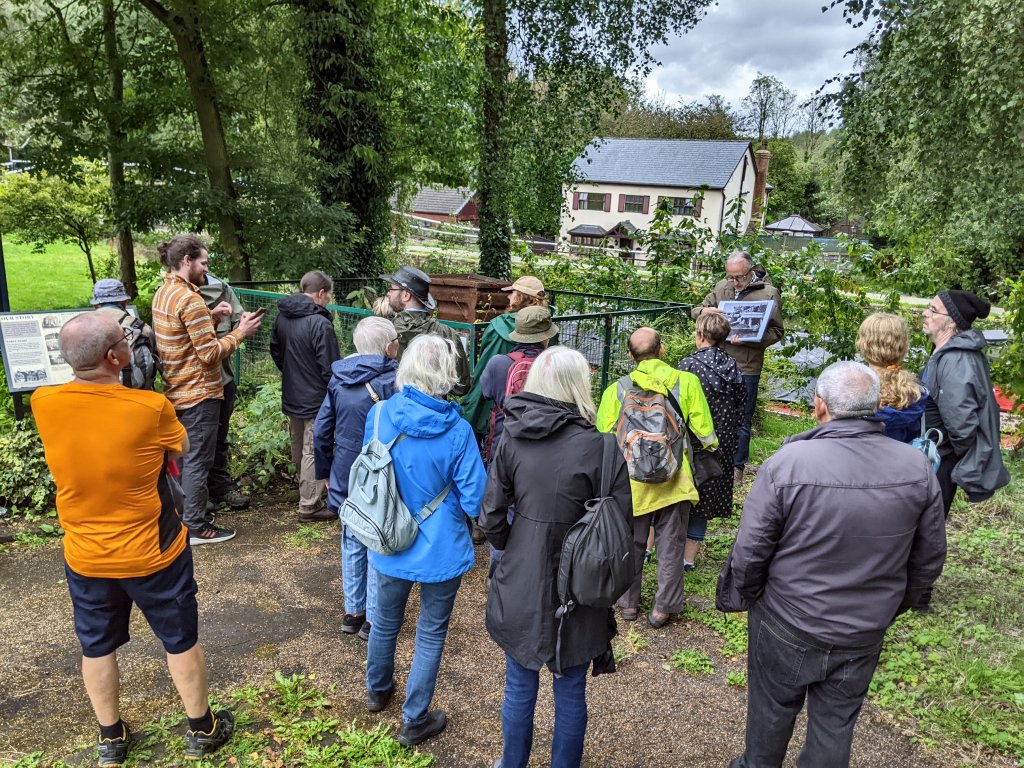Great turnout for this the first of our two summer trips this year. At the end of the month we will be visiting the prehistoric sites on Anglezarke and Rivington moors but today we had a much more sedate tour of the historic delights along the Leeds and Liverpool canal. Jim Meehan our guide has meticulously done his research on the stretch between Martland Mill and Crooke Village and as a result the trip was not only entertaining but informative as well.
Our starting point was the old canal bridge where Jim gave a gruesome description of a couple of drownings. One was a young man, being drunk on New Years eve, fell into the canal as he left the pub. The other was the driver who fell off his cart when it hit the corner while travelling over the bridge.
Crossing the bridge Jim led us along the canal towards the modern road bridge where he was able to show us the site of 19th century pottery works.
Making our way through a small wood, we found ourselves on the old main road that was once connected Standish Lower Ground with Kit Green and Pemberton beyond. Here Jim talked about the history of the Martland family (originally Markland) who lived in the 17th century manor house known as the Meadows (see Newsletter 239).  He also explained their connection with the Walthew family who lived at Walthew Hall which Jim described as being just up the road leading the huge Heinz warehouse. The was the one-time home of George Hoy Booth aka George Formby junior.
He also explained their connection with the Walthew family who lived at Walthew Hall which Jim described as being just up the road leading the huge Heinz warehouse. The was the one-time home of George Hoy Booth aka George Formby junior.
From there Jim took us across the footbridge over the River Douglas back towards Martland Mill Bridge. This is where Jim had located the likely position of the original Martland Mill, its ruins being described as such in a pre WWI newspaper article (see Newsletter No.239). It was most likely a water mill and probably for milling corn but may have later may have operated as a fulling mill. These mills were used for processing woollen fabric which fits with the Martland family who were involved in the cloth trade. The course of the Douglas original ran more or less where the canal is now, but altered when the Douglas Navigation was created in the mid 18th century (it is assumed the new cut followed the mill race and tail race for the mill). If this was the case, it can be inferred that the mill stopped operating when the Navigation was built.
From there Jim took us along the canal towpath towards Crooke stopping to just to look at a boundary stone marking the boundary between Wigan and Standish. Dated 1890, it marks the limits of the then newly created Wigan County Borough. 
Further along the towpath we stopped at the old Crooke canal lock which became redundant when higher locks were built at Gathurst in the early 19th century  (for this to happen, the canal from here to Gathurst must have been raised to the same level as the stretch before the lock).
(for this to happen, the canal from here to Gathurst must have been raised to the same level as the stretch before the lock).
Eventually we arrived at the footbridge over the canal leading to the main road at Standish Lower Ground.  This is where the Royal Oak pub used to be (the building has now been converted into flats).
This is where the Royal Oak pub used to be (the building has now been converted into flats).
From there we travelled down the side-road leading into Crooke Village itself. After cross the bridge over the Mill Brook we tuned left into what is now a large marina. This was the location of the old Crooke Hall, a large half-timbered house built in 1608 for Peter and Elizabeth Catterall. According to Ron Hunt (on Wiganworld), in 1951 the Hall was officially scheduled as being worthy of preservation. Alas unbeknown to the Ministry of Works it had been demolished fourteen years earlier.  Running to the east of the Hall, Jim described how a branch from the canal, built in the late 18th century, led into a tunnel in the hillside to connect with the mine workings of the later John Pit. The tunnel was abandoned in the mid 19th century when the workings became too deep.
Running to the east of the Hall, Jim described how a branch from the canal, built in the late 18th century, led into a tunnel in the hillside to connect with the mine workings of the later John Pit. The tunnel was abandoned in the mid 19th century when the workings became too deep.
Leaving the marina we arrive at our final destination, i.e. the end of the railway line from the Giants Hall colliery. This was the site of a tipping machine used to unload the coal wagons in to the canal barges.  Crooke is quite a pleasant village but this belies its origins as quite a rough pit village in the 19th and early 20th centuries.
Crooke is quite a pleasant village but this belies its origins as quite a rough pit village in the 19th and early 20th centuries.
To finish of the day, many of our party repaired to the Crooke Hall pub for a drink (and even lunch for some) before heading back along the canal to the cars parked at Martland Mill.  All in all a vey pleasant outing and I would like to thank Jim on the behalf of the Society for a very enjoyable and informative trip.
All in all a vey pleasant outing and I would like to thank Jim on the behalf of the Society for a very enjoyable and informative trip.
